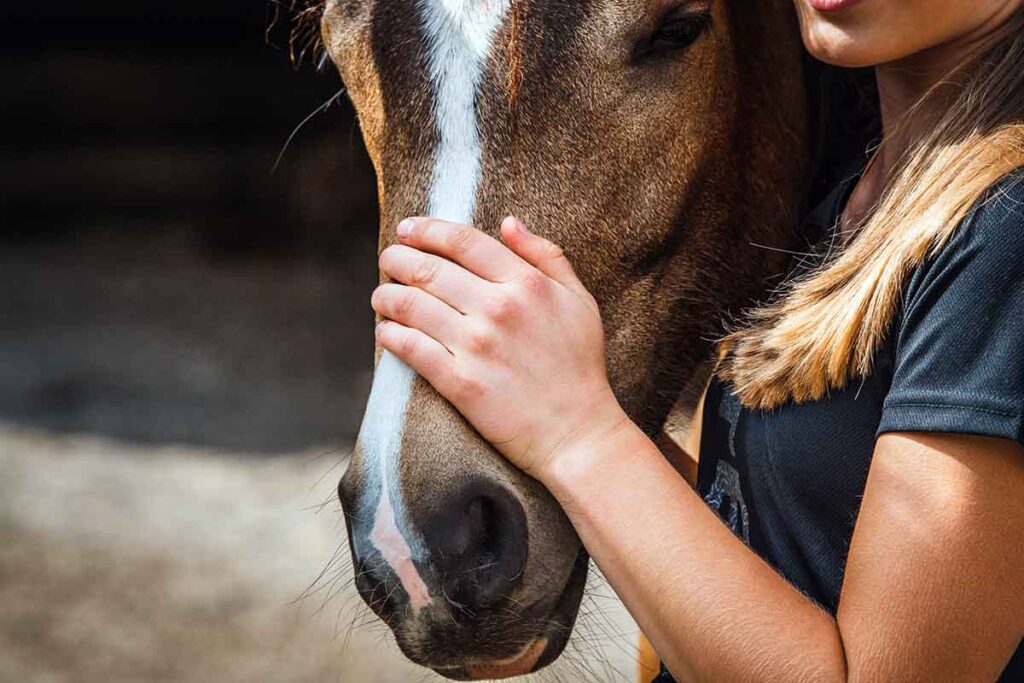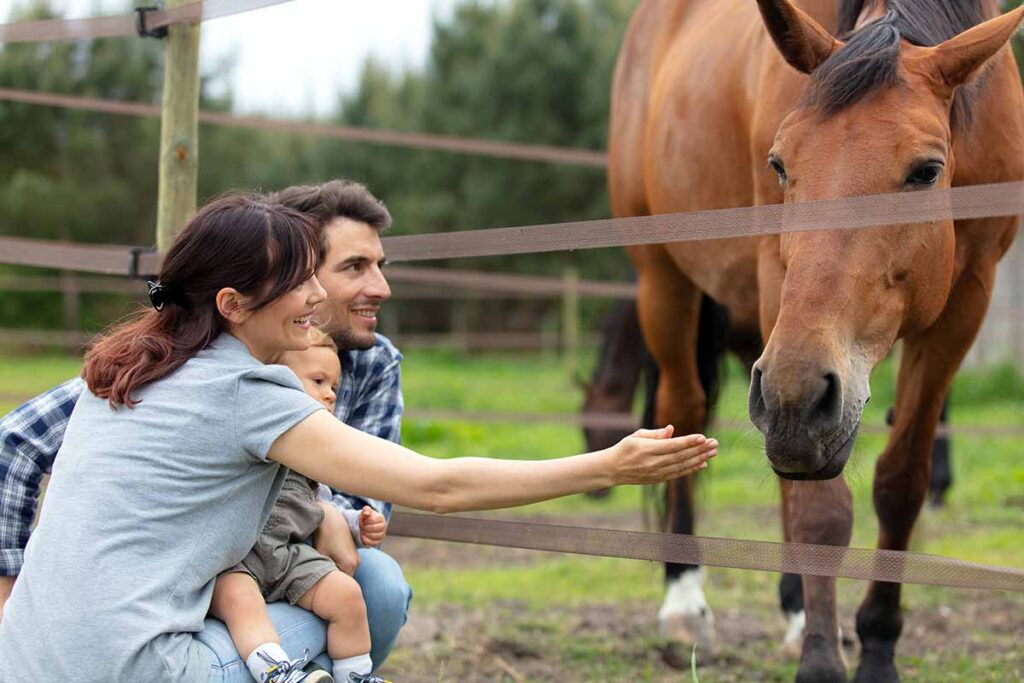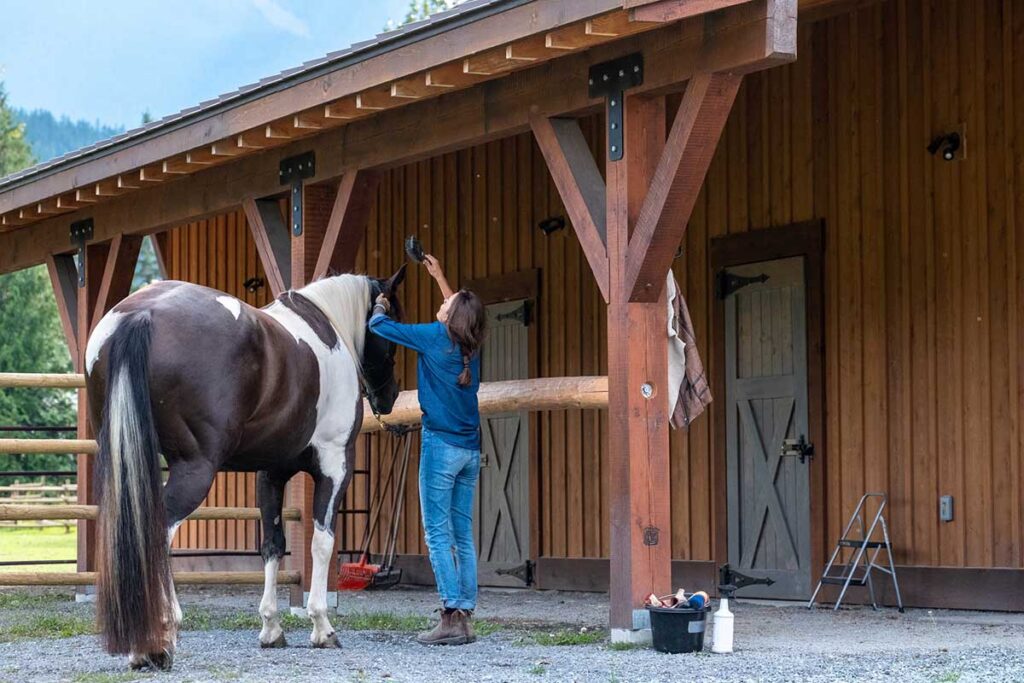You’ve got a routine when you get in the shower—wash hair, face, body, condition hair, and you’re on your way. Bathing your horse should be no different, save for a bit more fur, body area, and a moving target. In time, you’ll tailor these bathing steps to best meet your needs. But to start, here’s a step-by-step guide to bathing your horse.
Gather your supplies.
Some tools and supplies you might find handy when bathing your horse:
- A rubber mitt or curry comb
- Shampoo
- Bluing shampoo (if your horse has white markings)
- Mane and tail conditioner
- Coat conditioner
- Coat polish
- Mane and tail comb
- Hoof pick
- Bucket
- Sponge
- Clean rags
- A cooler or sheet
- Body brush
- Sweat scraper
You’ll quickly determine which items are must-haves and which ones your personal bath bucket can do without. And, of course, you’ll need a water supply—either a hose with a removable nozzle or several buckets of water.
If possible, find a skid-free, mud-free surface.
The best place to wash a horse has a surface that won’t become a mud puddle when wet. You also want a safe place to wash your horse that will drain and won’t become slick when wet. Gravel, textured concrete, or rubber mats are common wash-rack footings.
If you don’t have a dedicated wash rack with mud-free footing, use what you have at your disposal. Horses can still look fresh and clean after baths on grass, but you might have to deal with mud.
Tie your horse safely or have a friend hold him.
If your horse isn’t used to baths or you know he doesn’t seem to like them, have a friend hold him as you wash. Horses trained to stand for baths can be tied, but make sure you use a quick-release knot or, if using cross-ties, quick-release snaps in case your horse spooks.
Brush off obvious dirt before bathing.

If you want your horse to be spotless (if you’re going to a show, for example), brush off any dried or caked-on dirt prior to bathing so it doesn’t turn into mud when it gets wet.
If using warm water, check the temperature.
If you’re using water from a water heater, test the temperature with your hand before bathing your horse and keep tabs on it throughout the bath. If it gets too hot, you could risk scalding your horse.
Start spraying low, and work your way up your horse’s body.
Ensure your horse is comfortable with being sprayed by introducing water on an area of the body where he’s least likely to react. Start at the hooves and move up the legs slowly until you’re spraying the shoulder or stifle area. Rinse your horse’s entire body—don’t forget the mane and tail and under the belly—before applying shampoo.
Apply shampoo.
There are countless shampoos you can use on your horse; your choice typically comes down to personal preference. Some come as a concentrated body wash with a built-in sprayer that produces suds (which you can spray right onto the horse) at the flip of a dial. Others come in bottles and must be applied with your hands or a rubber mitt, sponge, or other bathing tool. Always follow the application instructions on the bottle—you can use some products at full strength while you need to dilute others.


If your horse is gray, largely white (i.e., Paints/Pintos, Appaloosas, etc.), or has white leg markings, you might want to add a bluing shampoo to your bathing regimen to brighten his coat. Generally, you’ll apply the shampoo to the white areas with a rubber mitt or other tool, scrub it in, and then let it sit for a short time before rinsing it off. Just like regular shampoo, check the instructions on the bottle for application times, to see if you must dilute it, and other important information.
Condition your horse’s mane and tail.
Read the application instructions on the bottle, and apply conditioner to your horse’s mane and tail as directed. Work it into the dock (the bone in the horse’s tail) and the base of the mane, as well.
Wash your horse’s face.

Some horses tolerate having their faces sprayed lightly with water on a low setting, but doing so can risk getting water and soap in a horse’s eyes and ears. Another option is to dilute gentle body wash or shampoo in a bucket and apply it to the face with a sponge. If you’re not confident you can remove all the soap from your horse’s face, skip shampoo and rinse with water only—spraying or sponging a face gently with water can remove a significant amount of dirt and grime.
Rinse thoroughly.
Left-behind shampoo and conditioner can make your horse itchy, so rinse his body thoroughly. Continue rinsing until all signs of soap and suds are gone. Pay attention to the horse’s mane and tail—any residue left behind can cause your horse to rub on fences, stall walls, and more, which could lead to a patchy mane or tail.
Remove excess water.
Once your horse is rinsed, use a sweat scraper to remove the excess water from his coat.
Detangle and comb manes and tails.

After a bath is a good time to apply mane and tail detangler and comb your horse’s locks. Use a wide-tooth comb or brush, start from the bottom, and work up to avoid accidentally pulling out or breaking hairs.
If it’s chilly, apply a sheet or cooler as your horse dries.
Walking horses while they dry helps keep them clean and prevents them from rolling while wet. If it’s cold out, a cotton sheet or fleece or wool cooler can help prevent them from getting chilled. If you’ve bathed your horse for an event, put a fresh, dry sheet on him once dry to keep him clean until showtime.
Pro tip: Avoid using new sheets in bold colors on light-colored horses, such as grays or pintos. The sheet’s color can bleed and stain the horse’s coat.
Take-Home Message
Give your horse a bath to cool him down on a hot day or to remove sweat and dirt that’s accumulated on his coat. Baths are also ideal opportunities to brighten white markings and condition and detangle manes and tails. With this guide, you can give your horse a rinse or a bath with confidence and ease.
Are you enjoying this content? Sign up for My New Horse’s FREE newsletter to get the latest horse owner info and fun facts delivered straight to your inbox!








